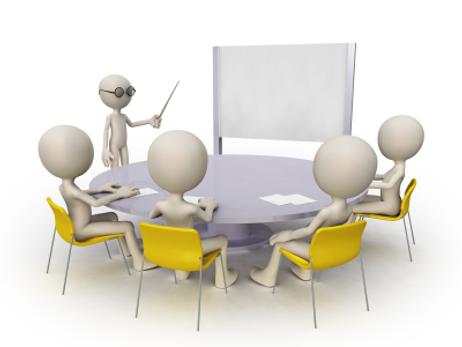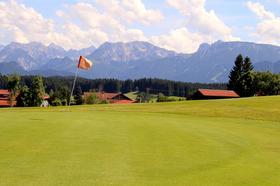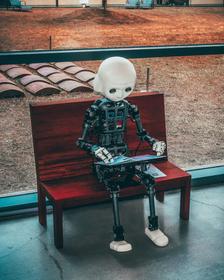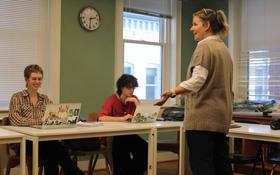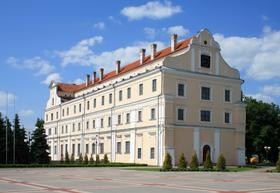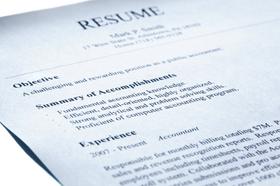Students sitting in rows of desks listening to a teacher lecture? You will not likely find this scenario in a school that uses Harkness Tables. The brainchild of wealthy industrialist Edward Harkness, an Exeter alumnus, Harkness Tables are oval tables that seat 12-18 students together with their teacher. You cannot hide in the back of a classroom that uses Harkness Tables. That's the point. Engaged students learn.
In ancient times, teaching was collaborative - think Socrates and Quintilian - but somewhere in our Victorian-Edwardian past, we got off the rails and lined children up in regimented rows of chairs and desks. Maria Montessori and Rudolph Steiner rebelled against this sort of regimentation. Their classrooms became what we would now call activity centers.
High school lab courses such as chemistry and physics have always been interactive and hands-on. Discussion of findings and research are encouraged in that collaborative environment. Every member of the class has an opinion and a finding. That is the idea behind the Harkness Table. Every member of the class is encouraged to be an active participant. Because eye contact is a critical element of this learning style, the Harkness Table's oval shape is ideal. It allows everybody around the table to see and be seen. Students and teachers interact. The teacher facilitates without dominating the lesson. He guides and steers the learning process. Maria Montessori would be thrilled.
From Melia Robinson's article Why The Classes At Phillips Exeter Are Different Than At Any Other Private School:
"Everyone Gets A Say At The Table
The Harkness method, with its small group setting, comes with an obligation to come to class prepared. Otherwise, it will be pretty obvious who did and didn't do their homework. Speaking up at the Harkness table, however, is just as important as drawing out others around you.
Remember that one kid in your high school class who never knew when to keep quiet?
"I used to be one of them," one student told me during my recent visit to Exeter. "I was talking a lot. But Exeter teaches you more than talking. It teaches you to listen."
The entire day I spent at Exeter, I don't think I heard one student talk over another. Students allowed their peers to finish phrasing a question or developing an idea before jumping in, just as well as they remembered to cite the text. They are encouraged to wait three seconds before responding to what the last person said, and to begin their contribution by repeating part of what the previous person said.
During my visit, I witnessed students' "discussion etiquette training" in action, on even the most minute of scales.
English instructor Becky Moore, who has taught at Exeter for more than 24 years, began her 200-level English class with a warm-up: She challenged the students to recite the alphabet as a group. No one person could say two letters in a row, and if two people talked at the same time, the group had to start over. It began, "A," "B," "C," and so on, at random.
Halfway through the alphabet, the students reached a standstill. No one spoke. Finally, a small girl wearing glasses piped in with the next letter.
Why the lull? A student later explained, 'Hillary was the only one who hadn't spoken yet, so I knew not to talk.'"
From the authorized maker of the Harkness Tables used at Exeter:
"Harkness Tables originated at Exeter in 1931 when philanthropist Edward Harkness challenged the Exeter faculty to create an innovative way of teaching that would include every child in the classroom learning experience. The result was an oval table that ensured that every student could be seen and every voice could be heard. Over time, the Academy settled on the current configuration of 6'-11" wide by 11' long with 12 equally-spaced slide-out surfaces for test taking."
Harkness Tables are widely used in prep schools here and abroad. Does the school you are looking at use Harkness Tables? Be sure to find out. Harkness teachers are all about collaborative learning. The format encourages discussion, sharpens students' thinking, and transforms the teacher into a partner in this adventure that is learning. It builds confidence. It reinforces the need to build an argument based on facts. It awakens the love of forensics (debating) in many students. It allows the teacher to see at a glance who understands the subject material, and who, perhaps, needs a little extra help.
The Harkness table method of learning encourages the kind of collaboration that students will use later in life in their daily work. It also complements the important private school concept of teamwork. In their balanced approach to educating the whole child, private schools teach the importance of teamwork across the academic curriculum, on the sports field, and in all their extracurricular activities.
Questions? Contact us on Facebook. @privateschoolreview

